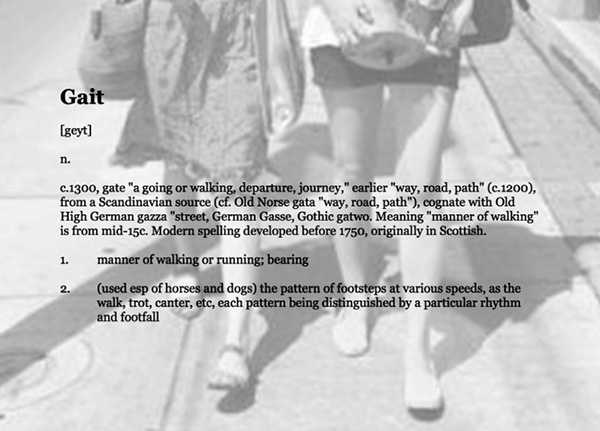
GAIT
first performed on September 1, 2016
Everywhere I go, Los Angeles, CA
performed ongoing in 2016
ALESSANDOR EARNEST
Los Angeles, California
613293539a613293539l613293539e613293539s613293539s613293539a613293539n613293539d613293539o613293539r613293539@613293539l613293539e613293539n613293539o613293539m613293539d613293539u613293539v613293539i613293539d613293539e613293539.613293539c613293539o613293539m
lenomduvide.com
GAIT
ALESSANDOR EARNEST
When I was a kid, I saw a crime show on TV where the detectives were looking at the way people walked on some security footage, trying to find a criminal. They said someone’s gait was even more distinct than a fingerprint. I took it as a challenge and began altering the way I walked for weeks at a time, taking tiny steps, taking longer steps, wider, criss-crossing, higher, dragging. I think I just wanted to see if anyone noticed.
I stopped doing that a long time ago but more recently came across an article about what body language says to observers. One of the things was that the way you walk can tell rapists you are an easy target. I started thinking about what elements of MY walk might make me look easily victimizable. I looked at the habits that made up my gait specifically to find what might make me look weak.
I had developed a bad slouch after having a partner much shorter than me. I often looked down when I walked to make sure I wouldn’t trip over anything. I stepped quietly and carefully, trying not to make a sound. I also made myself smaller so I wouldn’t accidentally brush up against someone.
My goal now is to permanently change my walk. I focus on my posture, making my back straight and squaring my shoulders. I hold my chin high, scoping out obstacles far ahead, rather than right in front of me. I swagger, pretending there are loose gears in my hips and stepping boldly (and loudly). I swing my arms and take up a lot of space. I notice that people move to accommodate me. I try to fill my walk with power and confidence. I look people in the eyes and smile.
It is not natural for me to walk this way; it takes considerable effort. But I will make the effort until it is natural and I no longer need to.
In conversation with Barbara T Smith about performance, she told me not to think of performance in the context of performers, but as a test of the limits of the body (like a car’s performance). I believe this work does test the limits of the body, but I still see performance and theatre as heavily linked. Performance attempts to separate itself from theater by removing the fourth wall and placing viewers on the same plane as the performer, but performance is inherently theatrical; there is a spectacle and a spectator. My difficulty with the word “performance” begins with the spectacle/spectator relationship. My work aims to remove the difference between the two. Even when the event is participatory, a work of performance begins with an action which is then presented to the viewer. The action itself tends to remain the most significant area of focus. I am much less interested in what I am doing than I am in the result of my actions.